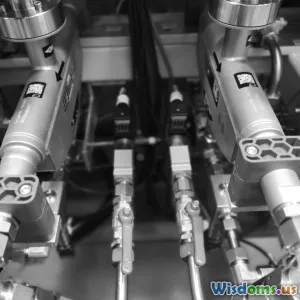
StepbyStep Guide to Automating Small Business Operations with AI
7 min read Unlock efficiency by automating your small business operations with AI—follow this step-by-step guide for success. (0 Reviews)
Step-by-Step Guide to Automating Small Business Operations with AI
In today's fast-paced world, small businesses constantly juggle limited resources against ever-growing demands. What if automation powered by Artificial Intelligence (AI) could be the key to unlocking unprecedented efficiency and growth? Imagine handling repetitive tasks effortlessly while focusing on innovation and customer satisfaction. This guide dives into how small businesses can harness AI for automating operations—step by step.
Why Automation Matters for Small Businesses
Most small businesses face a unique challenge: operating efficiently without the extensive staff or budget of larger enterprises. According to a McKinsey report, companies adopting AI-driven automation witnessed productivity increases of up to 20-25%. For small businesses, that leap translates directly into saved time, reduced human error, and cost savings.
Automation frees teams from monotonous tasks like managing supplier inventories, scheduling appointments, or sifting through emails. Instead, business owners can dedicate effort to improving products or engaging with customers in meaningful ways.
Step 1: Identify Repetitive and Time-Consuming Tasks
The roadmap to AI automation begins by pinpointing operations ripe for automation. Start by auditing your daily workflows:
- Administrative duties: Billing, invoicing, payroll processing
- Customer interactions: FAQs, appointment scheduling, support tickets
- Inventory management: Stock tracking, order placements
- Marketing efforts: Social media posting, email campaigns
For example, a local boutique might find manual inventory updates time-consuming and error-prone—ideal for automated AI inventory management.
Tools such as Toggl or RescueTime can help analyze where staff hours are spent, identifying prime automation candidates.
Step 2: Choose the Right AI-Powered Tools
With the list of automation targets, the next milestone is selecting AI tools that fit your business scale and needs. Leading categories include:
- Chatbots and virtual assistants: e.g., Drift or Intercom for customer support
- Accounting automation: QuickBooks with AI features to automate financial tracking
- Marketing automation: HubSpot or Mailchimp’s AI-driven campaign optimizations
- Inventory solutions: Zoho Inventory or TradeGecko for AI order and stock management
When selecting tools, consider integration with existing systems and ease of use. Gartner reports that low-code/no-code AI platforms provide SMBs with accessible customization, lowering entry barriers.
Real-world insight: A coffee shop in Seattle integrated an AI chatbot that handled 70% of its booking inquiries autonomously, freeing baristas' time to enhance customer experiences.
Step 3: Develop an Implementation Plan
Avoid adopting automation impulsively. Constructing a structured plan mitigates disruption risk.
- Pilot phase: Start small by automating one or two tasks.
- Team training: Ensure your employees are comfortable with AI tools.
- Evaluation metrics: Define KPIs such as reduced task completion time, error rate decreases, or customer response improvements.
- Feedback cycles: Collect employee and customer feedback regularly.
A boutique owner shared, “Our pilot with automated billing shortened processing from hours to minutes without hiccups, encouraging us to expand gradually.”
Step 4: Automate and Monitor Continuously
Begin automation with the pilot tasks identified. Utilize AI to schedule, execute, and optimize those processes. Keep monitoring performance through dashboards or reports:
- AI tools often employ machine learning that adapts and improves workflows automatically.
- Identify bottlenecks or failures early to readjust
- Update AI datasets regularly to maintain accuracy and relevance
Step 5: Scale Automation Across Business Operations
Once confident in your initial automation success, progressively expand:
- Integrate AI with CRM systems for personalized customer engagement.
- Use robotic process automation (RPA) for back-office compliance or data migration.
- Leverage AI-powered analytics to forecast demand, optimize pricing, and enhance inventory decisions.
A study by Deloitte highlights that businesses with advanced AI integrations grew revenue up to three times faster than counterparts.
Common Challenges and How to Overcome Them
Resistance to change: Engage staff early; demonstrate benefits.
Data privacy concerns: Choose AI providers with strong security measures complying with laws like GDPR.
Budget constraints: Start with affordable SaaS AI tools rather than building custom solutions.
Skill gaps: Invest in upskilling or leverage third-party AI consultants.
By addressing these barriers systematically, businesses can realize AI automation benefits safely and effectively.
Looking Ahead: The Future of AI Automation in SMBs
Automation powered by AI will only become more accessible and sophisticated. Emerging technologies like natural language processing will make AI interactions seamless, while advancements in edge computing will enhance real-time decision-making.
For any small business, embracing AI is not just about keeping pace with competitors—it’s about redefining what’s possible with constrained resources.
John Smith, CEO of AutomateNow, states, “Automating foundational processes with AI transforms small businesses from reactive entities into proactive market leaders.”
Conclusion
From identifying repetitive tasks to selecting smart AI tools, a careful, measured approach is the cornerstone of successful automation in small businesses. By embracing AI, small enterprises unlock efficiency, reduce costs, and create capacities for innovation. The journey requires commitment, but the rewards manifest in strengthened resilience and sustainable growth.
AI automation is no longer a luxury reserved for large corporations. It’s an imperative for small businesses eager to thrive amid ever-evolving economic landscapes.
Take the first step today—examine your workflows, explore AI tools, and embark on your automation journey.
References
- McKinsey & Company: "Artificial Intelligence: The Next Digital Frontier?" (2017)
- Gartner: "AI Adoption in SMBs" (2023)
- Deloitte Insights: "AI Transforming Business Growth" (2022)
- Legal frameworks: GDPR Compliance Guidelines
Ready to revolutionize your small business? With AI automation, opportunity awaits.
Rate the Post
User Reviews
Popular Posts





















